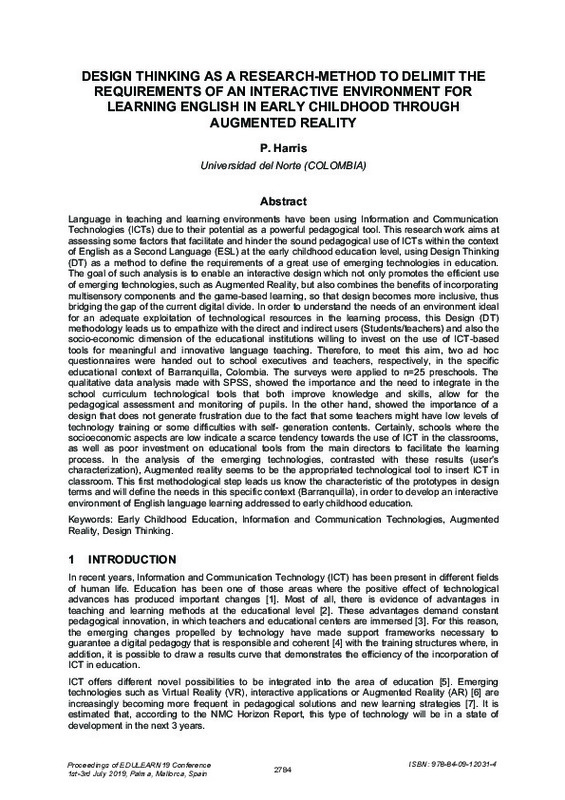JavaScript is disabled for your browser. Some features of this site may not work without it.
Buscar en RiuNet
Listar
Mi cuenta
Estadísticas
Ayuda RiuNet
Admin. UPV
Design thinking as a research-method to delimit the requirements of an interactive environment for learning english in early childhood through augmented reality
Mostrar el registro sencillo del ítem
Ficheros en el ítem
| dc.contributor.author | Harris-Bonet, Paola
|
es_ES |
| dc.date.accessioned | 2020-11-27T04:31:21Z | |
| dc.date.available | 2020-11-27T04:31:21Z | |
| dc.date.issued | 2019 | es_ES |
| dc.identifier.uri | http://hdl.handle.net/10251/155962 | |
| dc.description.abstract | [EN] Language in teaching and learning environments have been using Information and Communication Technologies (ICTs) due to their potential as a powerful pedagogical tool. This research work aims at assessing some factors that facilitate and hinder the sound pedagogical use of ICTs within the context of English as a Second Language (ESL) at the early childhood education level, using Design Thinking (DT) as a method to define the requirements of a great use of emerging technologies in education. The goal of such analysis is to enable an interactive design which not only promotes the efficient use of emerging technologies, such as Augmented Reality, but also combines the benefits of incorporating multisensory components and the game-based learning, so that design becomes more inclusive, thus bridging the gap of the current digital divide. In order to understand the needs of an environment ideal for an adequate exploitation of technological resources in the learning process, this Design (DT) methodology leads us to empathize with the direct and indirect users (Students/teachers) and also the socio-economic dimension of the educational institutions willing to invest on the use of ICT-based tools for meaningful and innovative language teaching. Therefore, to meet this aim, two ad hoc questionnaires were handed out to school executives and teachers, respectively, in the specific educational context of Barranquilla, Colombia. The surveys were applied to n=25 preschools. The qualitative data analysis made with SPSS, showed the importance and the need to integrate in the school curriculum technological tools that both improve knowledge and skills, allow for the pedagogical assessment and monitoring of pupils. In the other hand, showed the importance of a design that does not generate frustration due to the fact that some teachers might have low levels of technology training or some difficulties with self- generation contents. Certainly, schools where the socioeconomic aspects are low indicate a scarce tendency towards the use of ICT in the classrooms, as well as poor investment on educational tools from the main directors to facilitate the learning process. In the analysis of the emerging technologies, contrasted with these results (user¿s characterization), Augmented reality seems to be the appropriated technological tool to insert ICT in classroom. This first methodological step leads us know the characteristic of the prototypes in design terms and will define the needs in this specific context (Barranquilla), in order to develop an interactive environment of English language learning addressed to early childhood education. | es_ES |
| dc.language | Inglés | es_ES |
| dc.publisher | IATED, International Association of Technology, Education and Development | es_ES |
| dc.relation.ispartof | EDULEARN Proceedings (Internet) | es_ES |
| dc.rights | Reserva de todos los derechos | es_ES |
| dc.subject | Early childhood education | es_ES |
| dc.subject | Information and communication technologies | es_ES |
| dc.subject | Augmented reality | es_ES |
| dc.subject | Design thinking | es_ES |
| dc.title | Design thinking as a research-method to delimit the requirements of an interactive environment for learning english in early childhood through augmented reality | es_ES |
| dc.type | Artículo | es_ES |
| dc.type | Comunicación en congreso | es_ES |
| dc.identifier.doi | 10.21125/edulearn.2019.0757 | es_ES |
| dc.rights.accessRights | Abierto | es_ES |
| dc.description.bibliographicCitation | Harris-Bonet, P. (2019). Design thinking as a research-method to delimit the requirements of an interactive environment for learning english in early childhood through augmented reality. EDULEARN Proceedings (Internet). 2784-2793. https://doi.org/10.21125/edulearn.2019.0757 | es_ES |
| dc.description.accrualMethod | S | es_ES |
| dc.relation.conferencename | 11th International Conference on Education and New Learning Technologies (EDULEARN 2019) | es_ES |
| dc.relation.conferencedate | Julio 01-03,2019 | es_ES |
| dc.relation.conferenceplace | Palma de Mallorca, España | es_ES |
| dc.relation.publisherversion | https://doi.org/10.21125/edulearn.2019.0757 | es_ES |
| dc.description.upvformatpinicio | 2784 | es_ES |
| dc.description.upvformatpfin | 2793 | es_ES |
| dc.type.version | info:eu-repo/semantics/publishedVersion | es_ES |
| dc.identifier.eissn | 2340-1117 | es_ES |
| dc.relation.pasarela | S\401014 | es_ES |








